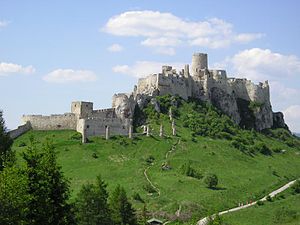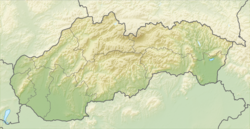Levoča, Spišský Hrad and the Associated Cultural Monuments
 |
|
| UNESCO World Heritage Site | |
|---|---|
| Location |
Slovakia |
| Includes |
Spiš Castle, Spišská Kapitula and St. Martin's Cathedral |
| Criteria | iv |
| Reference | 620 |
| Coordinates | 48°59′58″N 20°46′03″E / 48.9994°N 20.7675°E |
| Inscription | 1993 (17th Session) |
| Extensions | 2009 |
|
[]
|
|
The ruins of Spiš Castle is one of the largest castle sites in Central Europe. The castle is situated above the town of Spišské Podhradie and the village of Žehra that with adjacent ecclesiastical town Spišská Kapitula form components of the UNESCO World Heritage site. In 2009, the site was extended to include the famous altar by Master Paul of Levoča and the historic centre of Levoča with many well preserved Renaissance buildings.
Built in the 12th century, it was the political, administrative, economic and cultural centre of Szepes county. Before 1464, it was owned by Hungarian kings, afterwards (until 1528) by the Szapolyai family, the Thurzo family (1531-1635), the Csáky family (1638-1945), аnd (since 1945) by the state.
Originally a Romanesque stone castle with fortifications, a two-story Romanesque palace and a three nave Romanesque-Gothic basilica were constructed in the area by the second half of the 13th century. A second extramural settlement was built in the 14th century, which doubled the castle area. The castle was completely rebuilt in the 15th century. The castle walls were heightened and a third extramural settlement was constructed. A late Gothic chapel was added around 1470. The Szapolyai clan performed late Gothic transformations, which made the upper castle into a comfortable family residence, typical of late Renaissance residences of the 16th and 17th centuries. In 1780, the castle burned down and has been in ruins ever since. The castle was partly reconstructed in the second half of the 20th century, and extensive archaeological research was carried out on the site.
The old medieval town of the Levoča (Hungarian: Lőcse, German: Leutschau) is still surrounded by most of its 2,5 km long city walls. The main entrance to the old town is via the monumental Košice Gate, with the other two preserved namely Menhard, and the Polish Gate. The town square boasts three major monuments:
...
Wikipedia

